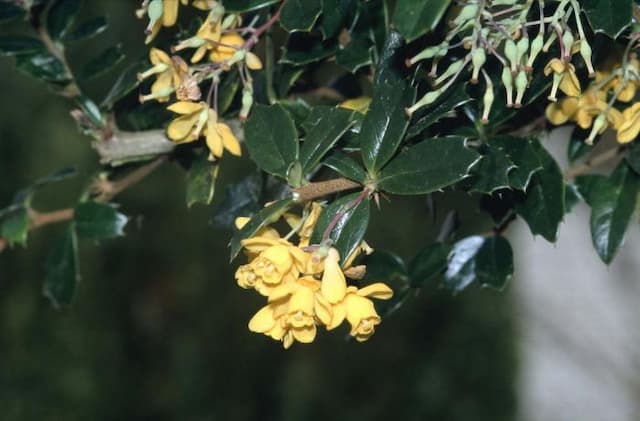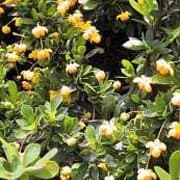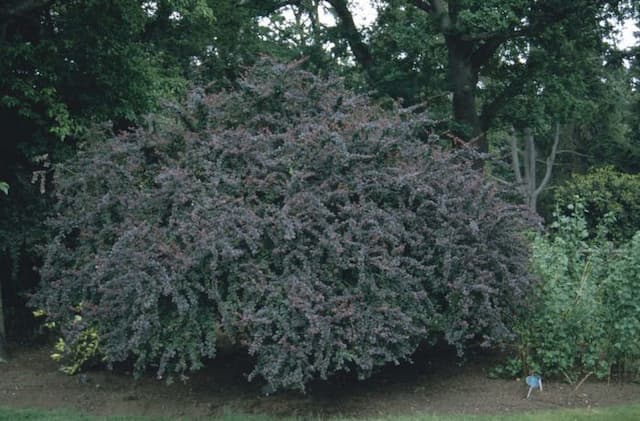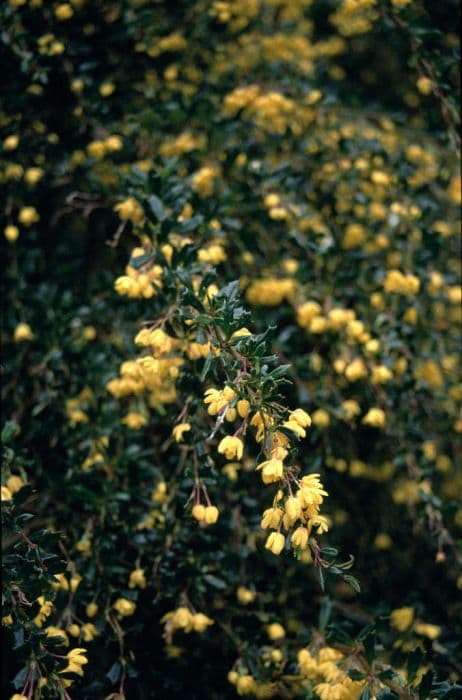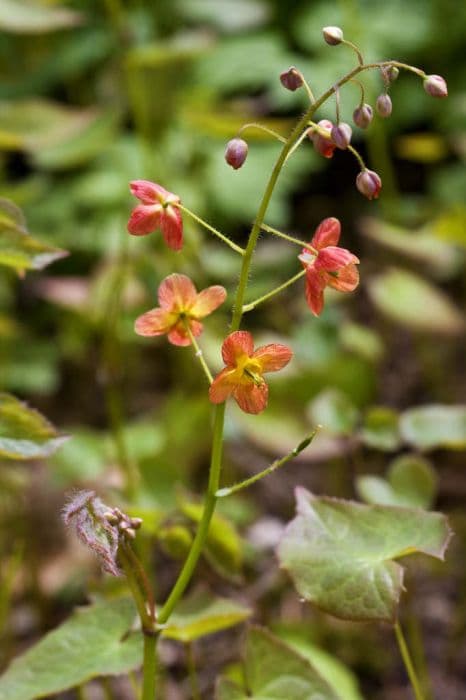Bishop's hat Epimedium grandiflorum 'Red Beauty'

ABOUT
The 'Red Beauty', commonly known as the Bishop's Hat, presents itself with an exceptional display of color and form. Its heart-shaped foliage emerges with a bronzy tint in the spring, gradually maturing to a lush green as the seasons progress. In the spring, delicate sprays of whimsical flowers float above the foliage, exhibiting a striking crimson color that adds a touch of vibrancy to the garden palette. Each flower on the 'Red Beauty' comprises a cup-like structure with spurs, resembling a fairy-tale depiction of a bishop's hat, which adds intricate detail and elegance to the plant's overall allure. The transition of leaves through shades of red, bronze, and green throughout the year provides a changing tapestry of color, ensuring that the Bishop's Hat maintains visual interest throughout the growing season.
About this plant
 Names
NamesFamily
Berberidaceae.
Synonyms
Bishop's Hat, Barrenwort, Fairy Wings, Horny Goat Weed.
Common names
Epimedium macranthum var. violaceum, Epimedium grandiflorum f. flavescens, Epimedium grandiflorum var. thunbergianum, Epimedium grandiflorum var. violaceum.
 Toxicity
ToxicityTo humans
Epimedium grandiflorum 'Red Beauty', commonly known as bishop's hat, does not have a notable level of toxicity to humans. These plants are generally not considered to be poisonous, and there are no well-documented cases of toxicity caused by ingestion of parts of this plant. In the absence of significant toxicological data, it is still advisable to exercise caution and avoid ingesting plant material, especially in significant quantities, as individual allergies or unexpected reactions cannot be ruled out entirely.
To pets
Bishop's hat is not widely known to be toxic to pets. There is limited information available on the toxicity of Epimedium grandiflorum 'Red Beauty' to animals, but it is generally considered to be of low toxicity, and there are no common reports of pets being poisoned by consuming this plant. As with any non-food plant, pet owners should still prevent their pets from ingesting the plant to avoid any potential gastrointestinal upset or unusual reactions, but the risk of serious toxicity is minimal.
 Characteristics
CharacteristicsLife cycle
Perennials
Foliage type
Semi-deciduous
Color of leaves
Mixed
Flower color
Red
Height
1-2 feet (30-60 cm)
Spread
1-2 feet (30-60 cm)
Plant type
Herb
Hardiness zones
5
Native area
Asia
Benefits
 General Benefits
General Benefits- Aesthetic Appeal: Epimedium grandiflorum 'Red Beauty', commonly known as Bishop's Hat, adds visual interest to gardens with its unique and colorful flowers.
- Drought Tolerance: Once established, Bishop's Hat is known for its ability to withstand periods of drought, making it suitable for xeriscaping.
- Shade Tolerance: This plant thrives in partial to full shade, making it a great option for shaded or woodland gardens.
- Ground Cover: With its spreading habit, it can provide an attractive ground cover, helping to suppress weeds and minimize soil erosion.
- Wildlife Attraction: The flowers can attract pollinators like bees, and the foliage can be a food source for certain butterfly larvae.
- Low Maintenance: Bishop's Hat requires minimal care once established, making it an excellent choice for gardeners looking for low-maintenance plants.
- Seasonal Interest: Its foliage often changes color in the fall, providing seasonal interest in the garden throughout the year.
 Medical Properties
Medical Properties- Libido enhancement: Epimedium grandiflorum, commonly known as "Horny Goat Weed," is often used in traditional Chinese medicine with a history of use as an aphrodisiac.
- Osteoporosis treatment: The icariin compound in Epimedium may help prevent bone loss in postmenopausal women.
- Erectile dysfunction: It is sometimes used to alleviate erectile dysfunction due to its purported effects on blood flow and nitric oxide levels.
 Air-purifying Qualities
Air-purifying QualitiesThis plant is not specifically known for air purifying qualities.
 Other Uses
Other Uses- Ground cover: Epimedium grandiflorum 'Red Beauty', commonly known as Bishop's Hat, can be used as an attractive ground cover due to its foliage and ability to thrive in shady areas.
- Drought-resistant gardening: Bishop's Hat is suitable for xeriscaping or drought-resistant gardening, as it is relatively drought-tolerant once established.
- Naturalizing: This plant spreads over time and can help create a natural, woodland look in gardens, integrating well with other shade-loving species.
- Border planting: Its distinctive flowers and foliage make Bishop's Hat an excellent choice for border edges in a garden setting.
- Wildlife garden: The blooms can attract pollinators such as bees when flowering, making it a valuable addition to a wildlife garden.
- Container gardening: Although often planted in the ground, Bishop's Hat can also be grown in containers to decorate patios and balconies.
- Fairy gardens: Due to its delicate foliage and blooms, it is a charming addition to fairy or miniature gardens.
- Floral crafts: The dried leaves and flowers can be used in floral crafts such as wreaths or dried flower arrangements for decorative purposes.
- Seasonal interest: This plant provides multi-season interest with flowers in the spring and colorful foliage in the fall.
- Erosion control: Bishop's Hat's extensive root system can help prevent erosion on shaded slopes and areas prone to soil loss.
Interesting Facts
 Feng Shui
Feng ShuiThe plant Bishop's Hat is not used in Feng Shui practice.
 Zodiac Sign Compitability
Zodiac Sign CompitabilityThe plant Bishop's Hat is not used in astrology practice.
 Plant Symbolism
Plant Symbolism- Vitality: Epimedium grandiflorum 'Red Beauty,' commonly known as "Bishop's Hat," is often associated with robust vitality due to its vigorous growth habit and the resilience it shows in various growing conditions.
- Sexual Health: This plant has a history in traditional medicine for supporting and enhancing sexual function, leading to its symbolic connection with sexual health and vitality.
- Long-lasting Love: The enduring nature of the plant, which can thrive for many years, symbolizes long-lasting and enduring love in relationships.
- Charm and Attraction: The striking appearance of its red blooms gives the plant a symbolic meaning of charm and magnetism, suggesting the wearer or user may attract or embody these qualities.
- Protective: In some cultures, it is believed that the Bishop's Hat plant has protective qualities, guarding against negative influences or energies.
 Water
WaterBishops Hat, commonly known as Epimedium grandiflorum 'Red Beauty', prefers consistently moist soil, especially during the growing season in spring and early summer. It should be watered thoroughly once the top inch of soil feels dry to the touch, which generally means once or twice a week, depending on the weather and soil conditions. Provide the plant with approximately one gallon of water at each watering session, ensuring even distribution across the soil to reach the root zone. During the hot, dry periods, increase the frequency to maintain soil moisture, but avoid overwatering, as this can lead to root rot. Reduce watering in the winter when the plant is dormant.
 Light
LightBishops Hat thrives in partial shade to full shade conditions. It should be planted in a spot that receives dappled sunlight or light shade throughout the day, avoiding direct afternoon sun which can be too intense. An ideal location would be under the canopy of taller trees or on the north side of a building, where it can receive the right amount of filtered light.
 Temperature
TemperatureBishops Hat performs well in a wide range of temperatures, but it is best grown in conditions where the temperature remains between 50°F and 75°F. It can withstand minimum temperatures down to 20°F, making it suitable for many temperate regions. However, during extreme cold or heat, it's important to provide protection to prevent damage to the plant.
 Pruning
PruningBishops Hat should be pruned to remove any damaged or dead foliage and to maintain its shape and size. The best time for pruning is in late winter or early spring before new growth starts. Cut back old foliage to ground level to allow room for fresh leaves. This also helps reduce potential diseases and encourages a healthy, tidy appearance. Generally, pruning once a year is sufficient for maintaining the health of the plant.
 Cleaning
CleaningAs needed
 Soil
SoilThe best soil mix for a 'Red Beauty' Epimedium, also known as Bishop's Hat, should be rich in organic matter, moist but well-drained, and have a pH range of 5.5 to 7.5. A mix of garden soil, leaf mold or compost, and a small amount of sand or perlite for drainage would be ideal for this plant to thrive.
 Repotting
Repotting'Red Beauty' Epimedium or Bishop's Hat does not require frequent repotting and can usually be repotted every 3 to 4 years. Repot only if the plant has outgrown its container or the soil has degraded.
 Humidity & Misting
Humidity & MistingBishop's Hat prefers average to high humidity levels. It is adaptable in household humidity, but for best growth, maintain humidity around 50% or higher if possible, without the need for extra measures like misting.
 Suitable locations
Suitable locationsIndoor
Place in bright, indirect light and ensure moist, well-draining soil.
Outdoor
Plant in partial shade, protect from intense sunlight, and use rich soil.
Hardiness zone
5-9 USDA
 Life cycle
Life cycleEpimedium grandiflorum 'Red Beauty', commonly known as Red Beauty barrenwort, emerges in early spring with new foliage tinged with red. As the season progresses, its leaves transition to green, and by late spring, clusters of spurred red and white flowers appear, attracting pollinators. After blooming, the plant enters a growth phase where the foliage matures and spreads, creating a ground cover effect. Throughout the summer, barrenwort remains mostly dormant but retains its foliage. In the fall, the leaves may acquire a reddish tinge before dying back with the onset of winter. New growth resumes the following spring, completing the perennial cycle.
 Propogation
PropogationPropogation time
Spring to Summer
Propogation: The most popular method of propagating Epimedium grandiflorum 'Red Beauty', also known as Barrenwort or Bishop's Hat, is by division. This is typically done in the late summer to early fall after the plant has flowered and as it enters dormancy. To propagate by division, carefully lift the clump of the plant from the ground using a spade, ensuring as much of the root system as possible is intact. Gently tease apart the rhizomes, making sure each division has at least one growth bud. Replant the divisions at the same depth they were originally growing at, spacing them approximately 12 to 15 inches (30 to 38 centimeters) apart. Water the new plants thoroughly to help establish them. This asexual propagation method maintains the true characteristics of 'Red Beauty'.
